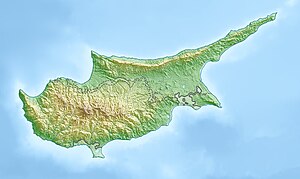Empa, Cyprus
Empa | |
|---|---|
 Panagia Chryseleousa | |
| Coordinates: 34°48′N 32°25′E / 34.800°N 32.417°E | |
| Country | |
| District | Paphos District |
| Population (2011)[1] | |
| • Total | 4,855 |
Empa (
History
The village already existed by the
Louis de Mas Latrie includes the village both amongst those that belonged to the family of the king of Cyprus during the period of Frankish rule, and as one of the king's villages that cultivated sugarcane. During 1468 the village had fallen under the region of Chrysochous, under the regional law officer (bailliage).[5]
Etymology
The appellation of the village is purely Greek, belonging to the Cypriot dialect. In this dialect Emba means "enter". It is possible that the name of the village was given because it is built at the entrance of Paphos, that is the edges of the city, through which the travellers from the north, northwest and west came in. Another version mentions that the name was given to the village because it is situated near the coast from where people departed from or arrived to Cyprus by sea, during the Byzantine era or even later during the period of Frankish rule. It is mentioned that King Peter I departed for Europe from the area in 1362. The village is noted as 'Emba' in medieval maps.
Monuments
The ancient church of Panayia Chryseleoussis is in the community. Built in the 12th century in
There are also a number of chapels in Emba such as the Byzantine chapel dedicated to Saint George (in the vicinity of
Recently a new church was constructed near the old one; it was dedicated to the apostle Andreas (
Economy
Emba has a few shops and tavernas dotted along the narrow winding road that runs through the village. In the evening the local men can be seen sitting outside their local coffee shops and often spilling out onto the narrow roads on their wooden chairs.
Personalities
Outstanding personalities of the village of Emba include the Bishop Anthimos of
Notes
- ^ "Population - Place of Residence, 2011". Statistical Service of Cyprus (CYSTAT). 17 April 2014. Archived from the original on 16 October 2014.
- ^ "Emba, Paphos". Cyprus Island. 2019-01-05. Retrieved 2023-07-08.
- ^ "Paphos, Emba - Property Canvas in Paphos". www.property-canvas.com. Retrieved 2023-07-08.
- ^ "Emba Paphou - Cyprus". Cyprus. Retrieved 2023-07-08.
- ^ "Empa". in-cyprus.philenews.com. 2019-01-10. Retrieved 2023-07-08.
- ^ "Emba community". Archived from the original on 2012-08-11. Retrieved 2008-08-09.


